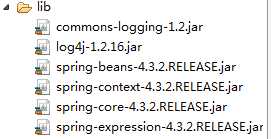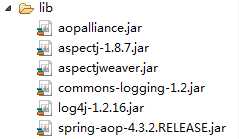标签:
Spring框架的作用
spring是一个轻量级的企业级框架,提供了ioc容器、Aop实现、dao/orm支持、web集成等功能,目标是使现有的java EE技术更易用,并促进良好的编程习惯。
Spring框架主要用于与其他技术(struts,hibernate等)进行整合,可将应用程序中的Bean组件实现低耦合关联.最终可以提高系统扩展和维护性.
将来我们利用Spring框架管理系统的各个组件(Action,Service,DAO).采用Spring的IOC和AOP机制实现各组件的关联.从而实现了低耦合调用.增强了系统可维护性和扩展性.
Spring基础jar包

Spring ioc 控制反转(Inversion of Control)
控制反转也被称为依赖注入,是面向对象编程中的一种设计理念,用来减低代码之间的耦合度。
IoC最大的好处是什么?因为把对象生成放在了XML里定义,所以当我们需要换一个实现子类将会变成很简单(一般这样的对象都是实现于某种接口的),只要修改XML就可以了,这样我们甚至可以实现对象的热插拔(有点像USB接口和SCSI硬盘了)。
例:
public class HelloSpring { private String who = null; public void print() { System.out.println("hello" + this.getWho()); } public String getWho() { return who; } public void setWho(String who) { this.who = who; } }
applicationContext.xml文件
<?xml version="1.0" encoding="UTF-8"?> <beans xmlns="http://www.springframework.org/schema/beans" xmlns:xsi="http://www.w3.org/2001/XMLSchema-instance" xsi:schemaLocation="http://www.springframework.org/schema/beans http://www.springframework.org/schema/beans/spring-beans.xsd"> <!-- services --> <!-- 通过bean元素声明需要Spring创建的实例,该实例的类型通过class属性指定,并通过id属性为该实例指定一个唯一名称,以便在程序中使用 --> <bean id="helloSpring" class="cn.cnsdhzzl.biz.HelloSpring"> <!-- 此处name属性的值对应类中属性的setWho,并为value属性赋值‘Spring’ --> <property name="who" value="Spring"> </property> </bean> <!-- more bean definitions for services go here --> </beans>
测试类:
@Test public void fristSpring() { // 从classpath路径中读取Spring配置文件,实例化Spring的上下文 ApplicationContext ac = new ClassPathXmlApplicationContext( "applicationContext.xml"); // 通过上下文的getBean方法,根据xml文件中的id属性值过去bean的实例 HelloSpring hs = (HelloSpring) ac.getBean("helloSpring"); // 实例调用方法 hs.print(); }
注:
ApplicationContext:是一个接口,负责读取Spring配置文件,管理对象的加载、生成,维护Bean对象与Bean对象质检的依赖关系,负责Bean的生命周期等。
ClassPathXmlApplicationContext:是ApplicationContext接口的实现类,用于从classPath路径中读取Spring配置文件(FileSystemXMLApplicationContext也可以用于加载Spring配置文件)。
相对于控制反转,依赖注入的说法也许更容易理解一些,即由容器(如Spring)负责吧组件所依赖的具体对象注入(赋值)给组件,从而避免组件之间以硬编码的方式组织在一起。
spring Aop(Aspect Oriented Programming)
在业务系统中,总有一些散落、渗透到系统各处且不得不处理的事情,这些穿插在既定业务中的操作就是所谓的“横切逻辑”,也陈伟‘切面’
面向切面编程,简单的说就是在不改变源程序的基础上为代码段增加新的功能,对代码段进行增强处理。
Aop一般适用于具有横切逻辑的场合,如切入日志、访问控制、事务管理、性能检测。
Aopjar包

例:
定义一个dao和实现
public interface UserEntityDao { public void save(UserEntity user); }
定义一个biz和实现
public class UserEntityBizImpl implements UserEntityBiz { private UserEntityDao dao; @Override public void save(UserEntity user) { dao.save(user); } public UserEntityDao getDao() { return dao; } public void setDao(UserEntityDao dao) { this.dao = dao; } }
创建前置增强类
//通过methodBeforeAdvice实现前置增强 public class LoggerBefore implements MethodBeforeAdvice { private static final Logger logger = Logger.getLogger(LoggerBefore.class); @Override public void before(Method method, Object[] arguments, Object target) throws Throwable { logger.info("调用" + target + "的" + method.getName() + "方法。" + "方法入参" + Arrays.toString(arguments)); } }
创建后置增强类
//通过afterreturningadvice实现后置增强 public class LoggerAfterReturning implements AfterReturningAdvice { private static final Logger logger = Logger .getLogger(LoggerAfterReturning.class); @Override public void afterReturning(Object returnValue, Method method, Object[] arguments, Object target) throws Throwable { logger.info("调用" + target + "的" + method.getName() + "方法" + "方法返回值:" + returnValue); } }
配置applicationContext.xml
<!-- 声明要创建的实体类 --> <bean id="daoImpl" class="cn.cnsdhzzl.dao.impl.UserEntityDaoImpl"></bean> <bean id="biz" class="cn.cnsdhzzl.biz.impl.UserEntityBizImpl"> <property name="dao" ref="daoImpl"></property> </bean> <bean id="loggerBefore" class="cn.cnsdhzzl.aop.LoggerBefore"></bean> <bean id="loggerAfterReturning" class="cn.cnsdhzzl.aop.LoggerAfterReturning"></bean> <!-- 定义切入点 --> <aop:config> <aop:pointcut id="pointcut" expression="execution(public void save(cn.cnsdhzzl.entity.UserEntity))" /> <!-- 插入增强处理(织入) --> <aop:advisor advice-ref="loggerBefore" pointcut-ref="pointcut" /> <aop:advisor advice-ref="loggerAfterReturning" pointcut-ref="pointcut" /> </aop:config>
注:
exection是切入点指示符,他的括号中是一个切入点表达式,可以配置要切入的方法,切入点表达式支持模糊匹配
execution(public * *(..))
execution(* set*(..))
AccountService接口定义的任意方法的执行:execution(* com.xyz.service.AccountService.*(..))
execution(* com.xyz.service.*.*(..))
execution(* com.xyz.service..*.*(..))
within(com.xyz.service.*)
within(com.xyz.service..*)
AccountService接口的代理对象的任意连接点 (在Spring AOP中只是方法执行):this(com.xyz.service.AccountService)
AccountService接口的目标对象的任意连接点 (在Spring AOP中只是方法执行):target(com.xyz.service.AccountService)
Serializable 接口的连接点(在Spring AOP中只是方法执行)args(java.io.Serializable)
execution(* *(java.io.Serializable)): args版本只有在动态运行时候传入参数是Serializable时才匹配,而execution版本在方法签名中声明只有一个 Serializable类型的参数时候匹配。@Transactional 注解的任意连接点 (在Spring AOP中只是方法执行)@target(org.springframework.transaction.annotation.Transactional)
@Transactional 注解的连接点 (在Spring AOP中只是方法执行):@within(org.springframework.transaction.annotation.Transactional)
@Transactional 注解的连接点 (在Spring AOP中只是方法执行)@annotation(org.springframework.transaction.annotation.Transactional)
@Classified 注解的连接点(在Spring AOP中只是方法执行)@args(com.xyz.security.Classified)
tradeService‘的Spring bean之上的连接点 (在Spring AOP中只是方法执行):bean(tradeService)
*Service‘的Spring bean之上的连接点 (在Spring AOP中只是方法执行):bean(*Service)
标签:
原文地址:http://www.cnblogs.com/cnsdhzzl/p/5908779.html